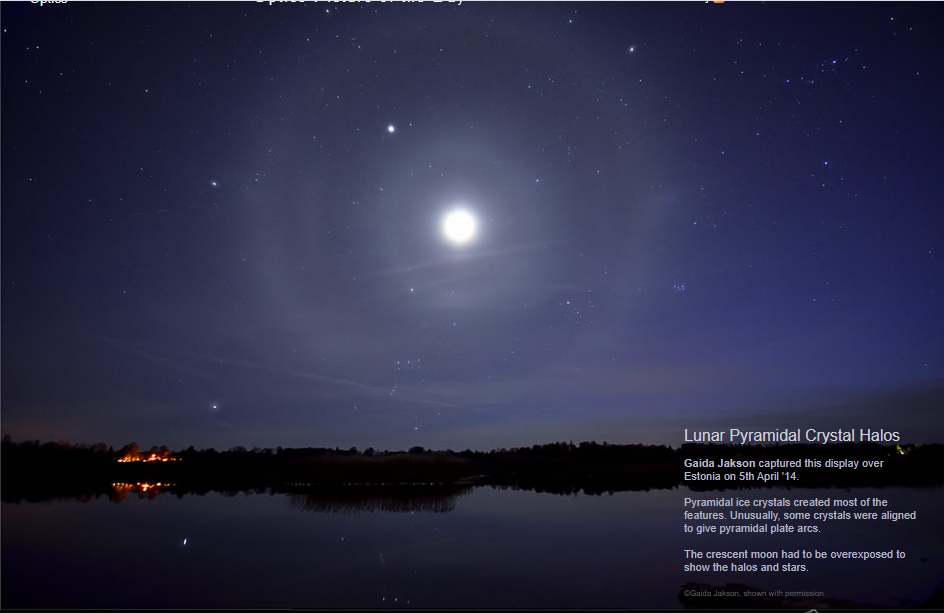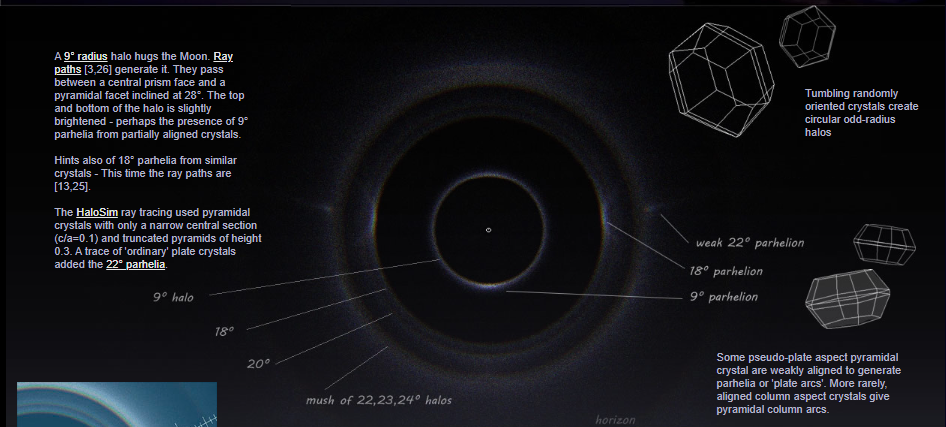Lunar Pyramidal Crystal Halos, Estonia - OPOD
Lunar Pyramidal Crystal Halos, Estonia - OPOD
Lunar pyramidal crystal halos are a captivating atmospheric phenomenon that can be observed in various locations around the world. One such occurrence was captured by Gaida Jakson over Estonia on April 5th, 2014. The display showcased a stunning interplay of light and ice crystals, resulting in the formation of unique pyramidal plate arcs.
The pyramidal ice crystals responsible for these halos exhibit an unusual alignment that gives rise to their distinctive shape. As light passes through these aligned crystals, it follows specific ray paths that generate the mesmerizing halo formations. In the case of the 9° radius halo hugging the Moon, the ray paths designated as .3,26 play a crucial role. These rays pass between a central prism face and a pyramidal facet inclined at an angle of 28°. The slightly brightened top and bottom of the halo suggest the presence of 9° parhelia, which are likely caused by partially aligned crystals.
Additionally, there are hints of 18° parhelia resulting from similar pyramidal crystals. This time, the ray paths responsible for their formation are designated as .13,25. The intricate interplay of light and crystal alignment contributes to the creation of these captivating optical phenomena.
To gain a deeper understanding of these lunar pyramidal crystal halos, researchers have employed HaloSim ray tracing techniques. By using pyramidal crystals with a narrow central section (c/a=0.1) and truncated pyramids of height 0.3, they were able to simulate the formation of the observed halos. Furthermore, the inclusion of 'ordinary' plate crystals in the simulation helped recreate the 22° parhelia commonly associated with these atmospheric optics events.
It is worth noting that not all pyramidal crystals contribute to the formation of halos. Some pseudo-plate aspect pyramidal crystals exhibit weak alignment, resulting in the generation of parhelia or 'plate arcs.' These phenomena add to the diversity and complexity of the overall display. Additionally, aligned column aspect crystals can occasionally give rise to pyramidal column arcs, further enriching the visual spectacle.
The rarity and beauty of lunar pyramidal crystal halos make them a fascinating subject for atmospheric optics enthusiasts and researchers alike. The intricate interplay between light and ice crystals creates a captivating display that showcases the wonders of our atmosphere. While this particular event was captured over Estonia, similar phenomena can occur in various locations worldwide.
As we continue to explore and study atmospheric optics, the opportunity to witness and document these unique displays provides valuable insights into the physics behind their formation. By unraveling the mysteries of lunar pyramidal crystal halos, we gain a deeper appreciation for the complexity and beauty of our natural world.

Lunar Pyramidal Crystal Halos
Gaida Jakson captured this display over Estonia on 5th April '14.
Pyramidal ice crystals created most of the features. Unusually, some crystals were aligned to give pyramidal plate arcs.
The crescent moon had to be overexposed to show the halos and stars.
©Gaida Jakson, shown with permission

A 9° radius halo hugs the Moon. Ray paths .3,26. generate it. They pass between a central prism face and a pyramidal facet inclined at 28°. The top and bottom of the halo is slightly brightened - perhaps the presence of 9° parhelia from partially aligned crystals.
Hints also of 18° parhelia from similar crystals - This time the ray paths are .13,25..
The HaloSim ray tracing used pyramidal crystals with only a narrow central section (c/a=0.1) and truncated pyramids of height 0.3. A trace of 'ordinary' plate crystals added the 22° parhelia.
Some pseudo-plate aspect pyramidal crystal are weakly aligned to generate parhelia or 'plate arcs'. More rarely, aligned column aspect crystals give pyramidal column arcs.
Note: this article has been automatically converted from the old site and may not appear as intended. You can find the original article here.
Reference Atmospheric Optics
If you use any of the definitions, information, or data presented on Atmospheric Optics, please copy the link or reference below to properly credit us as the reference source. Thank you!
-
<a href="https://atoptics.co.uk/blog/lunar-pyramidal-crystal-halos-estonia-opod/">Lunar Pyramidal Crystal Halos, Estonia - OPOD</a>
-
"Lunar Pyramidal Crystal Halos, Estonia - OPOD". Atmospheric Optics. Accessed on November 21, 2024. https://atoptics.co.uk/blog/lunar-pyramidal-crystal-halos-estonia-opod/.
-
"Lunar Pyramidal Crystal Halos, Estonia - OPOD". Atmospheric Optics, https://atoptics.co.uk/blog/lunar-pyramidal-crystal-halos-estonia-opod/. Accessed 21 November, 2024
-
Lunar Pyramidal Crystal Halos, Estonia - OPOD. Atmospheric Optics. Retrieved from https://atoptics.co.uk/blog/lunar-pyramidal-crystal-halos-estonia-opod/.